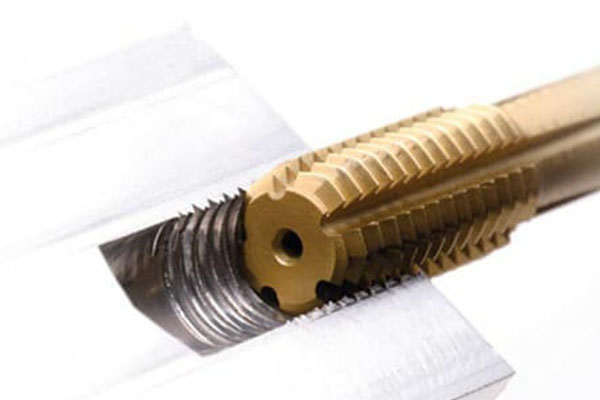Tapped Hole vs. Threaded Hole
Let’s examine the differences between tapping and threading, explain when each should be used, and determine which term—tapped holes vs. threaded holes—is more appropriate.

What is Tapping?
Tapping refers to the process of creating internal threads inside a hole to accommodate the installation of a screw or bolt. Consequently, a tapped hole is a hole with internal threading. The tapping process begins with drilling a hole that is usually slightly smaller in diameter than the major diameter of the threaded fastener that will be used.
To tap the hole, the next largest drill size beyond the calculated diameter is selected. For example, if the calculated drill diameter is 0.720 inches, the next largest tap diameter would be 0.750 inches.
Once the hole is drilled, threads are formed on the inner diameter of the hole using a tap. Taps resemble drill bits and come in various types, including hand taps, power taps, tapered taps, extension taps, and exotic taps. All taps bear a standard designation that provides important information. This includes the nominal size indicating the thread concentration and the thread form designation, which identifies the thread family (e.g., ACME, UNC, UNF, UNJ, UNS). The tap material is typically a robust material like carbide, and the pitch diameter tolerance is represented by an alphanumeric code that specifies the tolerance for the thread.
Tapped Hole Guidelines
Below are some guidelines for defining a tapped hole and selecting the appropriate tap type:
Prefer CNC Tapping:
Hand taps are not as precise or efficient as CNC taps. Whenever possible, choose CNC tapping for better results.
Consider Blind Holes:
For blind holes (holes that do not pass through the material), starting with a taper tap and then transitioning to a bottoming tap can improve thread definition. A bottoming taper tap threads almost all the way down, leaving only 1-2 tapered threads at the bottom. This enhances thread engagement in blind holes.
Avoid Spiral Point Taps for Blind Holes:
When CNC machining blind tapped holes, it’s best to avoid spiral point taps. These taps tend to push chips down into the blind hole, potentially causing assembly issues. Instead, opt for spiral flute taps or interrupted thread taps for blind holes.
Consider Thread Forming Taps:
Thread forming taps use chipless compression tapping, resulting in stronger threads and a longer thread lifespan with reduced risk of thread breakage. Keep in mind that thread forming taps require a larger tap drill diameter. Refer to resources like the “Machinery’s Handbook” for further details and calculations.
Clarify Clearance Holes:
While “clearance hole” is a common term used for threaded or tapped holes, most clearance holes are not actually tapped. They are designed for installing a nut on the free end to secure the materials together. A clearance hole is too small for the head of the fastener to pass through but large enough for the threaded portion to engage with the internal threads.
By following these tips, you can accurately define a tapped hole and choose the appropriate tap type for your specific application.
What is Threading?
Threading involves the process of creating external threads on the cylindrical body of a screw, bolt, or other parts like pipes. Unlike tapping, which creates internal threads within a hole, threading focuses on the external threads of the fastener. When referring to the location where a threaded fastener is installed, it is appropriate to use the terms “threaded hole” or “tapped hole.” However, it’s important to remember that the fastener itself is threaded, not tapped.
The threading process begins at the point of engagement of the fastener and extends through the body to the shank, which is the unthreaded portion of the fastener. For a detailed visual reference on threaded fastener terminology, please refer to the accompanying image at the beginning of this article.
Threaded fasteners have been widely used for many years and provide an effective means of securing multiple components in an assembly. Screws, in particular, have been extensively studied in mathematical and geometric contexts due to their ability to convert rotational forces, or torque, into linear force. One analogy to understand this concept is through the Archimedes screw, where rising water levels rotate a turbine connected to an electrical generator, generating power from a water source. The Archimedes screw serves as a power displacement pump.
Pro Tip: When tasked with designing a threaded fastener, it is usually advisable to opt for an off-the-shelf solution. However, if designing from scratch is necessary, utilize threading calculations and fastener calculations to assist in the design process.
Sungplastic: Key Tips to Remember
A tapped hole is synonymous with a threaded hole, and tapping refers to creating internal threads within a hole.
The distinction between a threaded hole and a tapped hole lies in the terminology used, with tapped hole specifically highlighting the use of a tap to create threads.
A drilled hole is the result of removing a cylindrical section of material, leaving smooth internal walls. In contrast, a tapped hole has internal threads.
Sungplastic is a reliable provider for custom CNC part manufacturing. We specialize in machining tapped holes of various sizes in different materials. Our intelligent, streamlined, and automated workflows simplify the process of custom part sourcing, making part procurement faster, easier, and more efficient. Choose Sungplastic as your go-to operating system for custom manufacturing needs.
In addition, we specialize in the production and handling of threaded inserts, as well as insert molding and overmolding.
Please directly contact us for your projects!
Get a free quote and design analysis today.
We’ll reply to you within 6 working hours.
We respect your privacy.
+86 139 2927 4777 (WhatsApp, Wechat)
